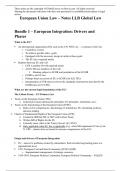These notes are the copyright of GlobalLawyer on Stuvia.com. All rights reserved.
Sharing the document with those who have not purchased it is prohibited and subject to legal
action.
European Union Law – Notes LLB Global Law
Bundle 1 – European Integration: Drivers and
Phases
What is the EU?
An international organization (IO), such as the UN, WTO, etc. – a creature of intl. law
o Created by a treaty
o To achieve specific tasks / goals
o Equipped with the necessary design to achieve those goals
o The EU has a regional nation
Relation between EU and CoE
o COE is another IO with regional nature
o All EU MS are members of the CoE
Meaning subject to ECHR and jurisdiction of the ECtHR
o ECHR is not EU law
o Perhaps future accession of EU to ECHR (Art 6(2) TEU)
o Interpretation of CFR must not lower the standards of protection provided by the
ECHR (See Art 53 CFR)
What are the current legal foundations of the EU?
The Lisbon Treaty – EU Primary Law
1. Treaty on the European Union (TEU)
a. General provisions (democratic principles, EU principles, institutions, etc.)
2. Treaty on the Functioning of the European Union (TFEU)
a. Rules on EU competencies, functioning of: institutions, EU citizenship, policies,
decision making
3. Charter of Fundamental Rights of the European Union (CFR)
a. Created in 2000 but EIF in 2007 with Lisbon Treaty
b. Written Bill of Rights for the EU
c. Currently same value as the Treaty (See art. 6(1) TEU)
d. Only applicable when EU law is applicable (e.g., when MS implement EU law) (Art.
51 CRF – charter does not intend to increase competencies of the EU)
Origin and drivers of European Integration
EU – answer to problems created by nationalism. Push towards long-lasting peace at a
supranational level
1951: European Coal and Steel Community (ECSC) (6MS)
o Supranational management of strategic resources
1950-1954: European Defense Community, European Political Community – FAILED
,These notes are the copyright of GlobalLawyer on Stuvia.com. All rights reserved.
Sharing the document with those who have not purchased it is prohibited and subject to legal
action.
1957: European Economic Community (EEC) – Treaty of Rome
o Gradual creation of common market: common custom tariff; removal of internal
barriers to trade; circulation of economic factors (4 freedoms)
o Why? Common market leads to political integration through spill-over effects,
interconnectedness.
o Strategies: limiting national aid to domestic industries, limiting protective and
discriminatory national regulation, limiting anti-competitive actions
European integration – 3 words
1. Enlargement
a. From 6 to 27 MS
b. Admission of new MS: Art. 49 TEU
i.
c. Values referred to in Art. 2 TEU:
i.
d. Withdrawal: Art. 50 TEU
e. Expulsion not possible, but Suspension: Art. 7 TEU
2. Deepening – expansion of competencies
a. Common market to Single market
b. Negative integration to positive integration (from no obstacles to harmonization)
(Art 114 TEU)
c. Treaty of Maastricht (1992)
i. Union citizenship; subsidiarity
ii. New policies: consumer protection, public health, monetary union
d. Treaty of Amsterdam (1997)
i. Reference to fundamental rights, Rule of Law, openness
ii. Communitarization of asylum and immigration policies
3. Legitimacy – EU as representative democracy
a. TEU Arts. 9-12 – Democratic principles
i.
ii.
b. Sui generis nature of the EU
i. Like an international organization (founded by treaties)
ii. But also like a state (representative democracy; accountable to individuals
directly and indirectly)
iii. Both individuals and MS are constituent subjects
How to Leave the EU
,These notes are the copyright of GlobalLawyer on Stuvia.com. All rights reserved.
Sharing the document with those who have not purchased it is prohibited and subject to legal
action.
Art. 50 TEU – Any Member State may decide to withdraw from the Union
o (Pre Lisbon treaty – no clause to withdraw – Public International Law applies)
o Initiative – Art 50(1) TEU – Any MS may withdraw in accordance with its own
constitutional requirements
o Relations with EU and leaving MS – Art. 50(2) TEU – MS which decides to
withdraw shall notify the European Council of its intention
o Negotiation phase:
o Is a deal necessary:
Deal is preferred according to Art. 50 TEU
Otherwise, withdrawal takes effect 2 years after notification
Extension in case of prolonged negotiations possible according to Art.
50(3) TEU
o Can MS withdraw its intention to withdraw?
No answer in Treaties
Case C-621/18
CJEU decides that yes, MS can withdraw its withdrawal
Reasoning:
o Purpose of Art 50 TEU: ensuring states have a right to
leave, but not forcing them to leave
o Principles of International Law – Art. 68 VCLT –
notification of withdrawal may be revoked before it takes
effect.
o Principles of EU law: EU created to create an even closer
Union of the peoples of Europe, for liberty and democracy –
therefore MS should be allowed to remain members
Brexit timeline
o 2016 – UK referendum to leave EU
o 2017 – EC receives letter from British PM declaring its intention
How and by whom is this decided? – Domestic constitutional question
according to Art. 50 TEU
, These notes are the copyright of GlobalLawyer on Stuvia.com. All rights reserved.
Sharing the document with those who have not purchased it is prohibited and subject to legal
action.
Bundle 2 – The Legislative Function in the EU
The EU’s Political Institutions:
Art. 13 TEU: EU shall have institutional framework to promote its values, advance its
objectives, and serve its interests, those of its citizens, and those of the MS
Art. 13(2): The Union’s institutions shall be:
o The European Parliament
o The European Council
o The Council
o The European Commission
Separation of powers in the EU: not separation of powers as traditional in a unitary state,
but separation of protected interests.
o EU as a whole: represented by the Commission (as an executive)
o Citizens: represented directly by EU Parliament
o Member States represented by the Council and the European Council
The institutions:
1. European Commission (The Commission)
a. Promotes general interests of the EU (Art 17(1) TEU
b. Secures application and effectiveness of EU Law (Art. 17(1) TEU
i. Can broadly be associated with the executive branch of the EU
c. Composition Art. 17 TEU, arts 244-250 TFEU)
i. President (5-year terms) (U. von der Leyen) – proposed by European
Council, approved by EU parliament
ii. College of Commissioners
1. 1 for each MS (rotation ex art 244 TFEU never applied), 5 years,
independent – represents not MS, but DGs
2. Organized in Directorates-General (DGs) responsible for different
policy areas
3. Collegial body (EU Parliament votes entire Commission – not
specific members)
iii. EU’s High Representative (Art. 18 TEU)
1. 2 hats: is a commissioner & sits in the Council / responsible for
Union’s common foreign and security policy
2. Nominated and can be removed by European Council
d. Democratic accountability (collegial): censure vote by European Parliament – Art
17(8) TEU and 234 TFEU
e. Functions: Art 17 TEU






